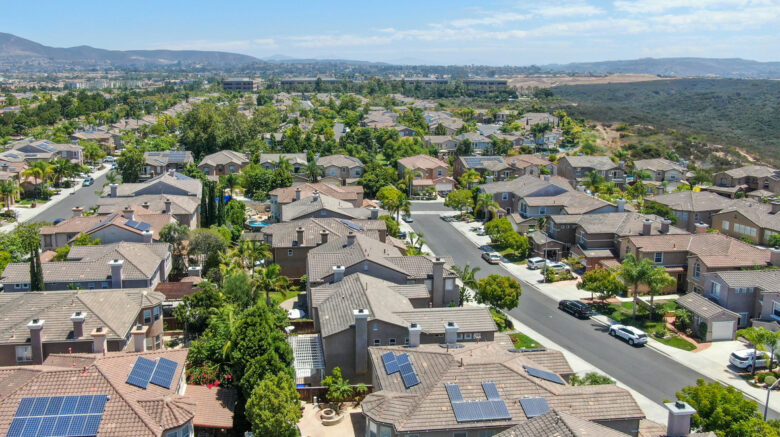On May 24th, the San Diego County Board of Supervisors is scheduled to vote on an SDG&E-backed plan that will set the stage to spend billions of ratepayer dollars on unnecessary long distance power lines. It will also cut the legs out from under rooftop solar.
If the plan passes, it’ll set the stage for higher utility bills and more SDG&E profits. It will also increase the chances of solar taxes and other penalties for making your own energy from the sun. Here’s how:
Rooftop solar and batteries save everyone money, even those without solar
When people and businesses make energy from their own roof, they use long-distance power lines less. Over time, this reduces the cost of building and maintaining those power lines and other grid infrastructure–by as much as $120 billion statewide over the next 30 years.
So why are County Supervisors voting on a plan to undermine rooftop solar?
The proposed plan, called the Regional Decarbonization Framework (RDF), is intended to map out the cheapest and quickest way for San Diego to meet the state’s clean energy goals.
The plan ought to take a balanced approach: First, get as much solar panels and batteries as possible on homes, businesses, and parking lots. Then, make up the difference with solar farms, wind farms, and transmission lines as needed.
Instead, the county’s draft plan does the opposite. It dismisses rooftop solar and calls for:
- A massive build-out of solar and wind farms in the undeveloped backcountry.
- Nearly $4 billion in new spending on long-distance power lines.
The plan is being challenged in court, and for good reason.
The plan’s math is off. Way off.
The plan lowballs the cost of long-distance solar and wind farms, while inflating the cost of rooftop solar
- The RDF calls for spending on two projects: $3.9 billion to support remote solar and wind development and $89 million for a local San Diego area upgrade to support energy storage
- But the RDF only uses the $89 million cost to calculate the cost of the program, and doesn’t include the $3.9 billion expense.
- In addition, the RDF assumes that the cost to operate a remote solar project is about $30 per megawatt hour (MWh). This ignores the cost of transporting that energy over long distance power lines. Once that is factored in, the actual cost is more than $120/MWh.
- Meanwhile, the RDF inflated the cost of commercial rooftop solar, using an outdated cost of $92/MWh. That’s nearly double the 2022 National Renewable Energy Laboratory cost of $50/MWh (NREL source, Solar PV – Dist. Comm” tab, Line 330, Column P – 2023, “Advanced”)
The plan dismisses rooftop solar’s potential
- The RDF presents two solar rooftop potential estimates for San Diego County: around 20,000 megawatts (MW) and 3,360 MW. The larger number is backed up with extensive documentation. The lower number has no supporting evidence.
- Despite that, the report concludes that the lower number is the correct one, and concludes that rooftop solar can only play a minor role going forward.
The actual math shows rooftop solar is cheaper and has huge potential to meet the county’s energy needs
The data shows that it costs twice as much to build solar farms than it does to install solar on on big box stores, factories, farms, churches and schools. Meanwhile, the potential for rooftop solar is nearly 6 times greater than the report claims.
Bottom line, the report is inconsistent and riddled with bad data. The County should not approve the RDF in its current form.
SDG&E’s fingerprints are all over the County’s plan
SDG&E is smart enough to put some distance between them and the plan, but it’s easy to find their fingerprints by looking under the hood.
The plan was guided and co-authored by an academic consultant, political science Professor David Victor. Dr. Victor has well-known ties to SDG&E and the utility industry:
- He sits on the Advisory Council of the utility industry’s national research association, Electric Power Research Institute (EPRI).
- SDG&E contributed almost $850,000 to EPRI in 2021. In that same year, EPRI pledged $900,000 to the UCSD institute that Prof. Victor runs in 2021, with the pledge specifically stating the money is to be controlled by Dr. Victor.
- Dr. Victor co-authored SDG&E’s 2022 decarbonization plan, which like the RDF, calls for more solar farms and power lines.
It makes sense that SDG&E wants to build more solar farms and reduce rooftop solar. After all, they make a 10-12% guaranteed profit for every dollar they spend on long distance power lines to transport electricity from solar farms.
San Diego County’s plan sets the stage for more attacks on your solar
This is right from the utility playbook:
1) Utilities lobby for billions of dollars in unnecessary infrastructure spending.
2) Rates go up. Utilities collect big profits.
3) Utilities blame rooftop solar for higher rates. They then lobby for solar taxes to stop people from installing solar panels.
4) Politicians oblige to make their donors happy and deflect blame for rising rates.
We saw utilities and state officials use this argument to justify multiple solar tax proposals over the past two years. We fought them all off. Let’s prevent more solar tax proposals by nipping them in the bud.

